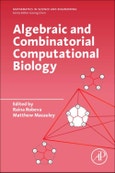Algebraic and Combinatorial Computational Biology introduces students and researchers to a panorama of powerful and current methods for mathematical problem-solving in modern computational biology. Presented in a modular format, each topic introduces the biological foundations of the field, covers specialized mathematical theory, and concludes by highlighting connections with ongoing research, particularly open questions. The work addresses problems from gene regulation, neuroscience, phylogenetics, molecular networks, assembly and folding of biomolecular structures, and the use of clustering methods in biology. A number of these chapters are surveys of new topics that have not been previously compiled into one unified source. These topics were selected because they highlight the use of technique from algebra and combinatorics that are becoming mainstream in the life sciences.
Please Note: This is an On Demand product, delivery may take up to 11 working days after payment has been received.
Table of Contents
1. Multi-scale graph-theoretic modeling of bimolecular structures 2. DNA nanostructures: Mathematical design and problem encoding 3. Graphs associated with DNA rearrangements and their polynomials 4. Regulation of gene expression by operons: Boolean, logical, and local models 5. Modeling the stochastic nature of gene regulation: probabilistic Boolean networks 6. Inferring interactions in molecular networks via primary decompositions of monomial ideals 7. Analysis of combinatorial neural codes: an algebraic approach 8. Predicting neural network dynamics: insights from graph theory 9. Multistationarity in biochemical networks: Results, analysis, and examples 10. Optimization problems in phylogenetics: Polytopes, programming and interpretation 11. Clustering via self-organizing maps on biology and medicine 12. Toward revealing protein function: Identifying biologically relevant clusters with graph spectral methods








